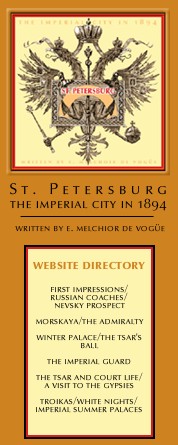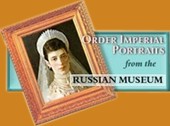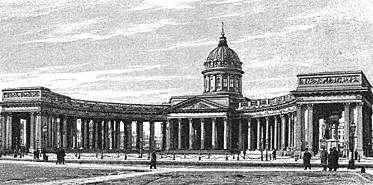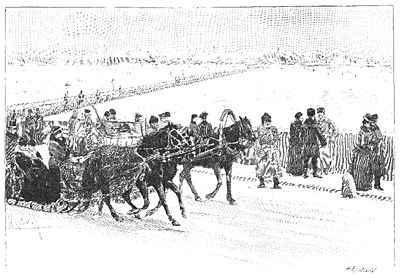


 | 
GREAT MORSKAYA - THE ADMIRALTY
Continuing our walk along the Neva Perspective, we are stopped by the Admiralty. The sledge turns to the right into the wide Morskaya, or Great Marine Street, the rendezvous of well-dressed walkers, corresponding with the Regent Street of London or the Rue de la Paix of Paris, lined as it is with fine shops, fashionable restaurants, and private hotels. It leads to the cathedral of St. Issac's, with its golden cupolas surmounting a huge square mass of granite that seems to be gradually sinking into the ground. A risky thing it was truly to set a mass like this upon a foundation of piles! Eternal night reigns inside beneath the domes, tempered, however, by the light of hundreds of little candles constantly renewed by the faithful in front of the shrines, their flames touching with light the gold of the mosaics and the silver-gilt saints carved on the walls of the sacred building. The light of day only penetrates through the great north window, and it seems to come from the sad eyes of the Saviour painted upon the glass. Like Notre Dame de Kazan, the cathedral of St. Issac's impresses the visitor by its size and the Oriental richness of its decorations, but both are wanting in that which makes the charm of the little churches of the Kremlin, and, indeed, of all places for prayer-that antiquity which is the accumulated soul of generations of worshippers.
 Passing round the cathedral, one comes to the Neva, glancing en passant at the fine bronze statue of Peter the Great by Falconnet, beside the river. The Czar is on horseback, in the costume of a Roman Emperor, and seems by an effort of his Imperial will to be calling up from the desert marshes the city of his dream. We come out upon the long line of quays, and before us is the chief marvel of St. Petersburg-the dike of red Finland granite, which hems in for a length of more than three miles the river Neva, which is here as wide as an arm of the sea. The stream is arrested beneath its thick crust of ice, and foot-passengers and equipages of all kinds are passing to and fro on it, while in the middle sportsmen are thronging round the course marked out for the races, and in the distance we see the tents of skins of some wandering Laplanders, in front of which pace reindeer with children riding on their backs. Opposite, on the northern bank, the cathedral of St. Peter and St. Paul overlooks the bastions of the citadel. The twilight sky is cleft open by what looks like a fixed flash of lightning, gleaming as would a bar of fire; this is the slim but lofty pinnacle of the belfry; a ray of light from the invisible sun has struck it as it rises above the fog and mist. The luminous sign marks the last resting place of the Romanovs, where they have all been laid near the founder of their dynasty. Passing round the cathedral, one comes to the Neva, glancing en passant at the fine bronze statue of Peter the Great by Falconnet, beside the river. The Czar is on horseback, in the costume of a Roman Emperor, and seems by an effort of his Imperial will to be calling up from the desert marshes the city of his dream. We come out upon the long line of quays, and before us is the chief marvel of St. Petersburg-the dike of red Finland granite, which hems in for a length of more than three miles the river Neva, which is here as wide as an arm of the sea. The stream is arrested beneath its thick crust of ice, and foot-passengers and equipages of all kinds are passing to and fro on it, while in the middle sportsmen are thronging round the course marked out for the races, and in the distance we see the tents of skins of some wandering Laplanders, in front of which pace reindeer with children riding on their backs. Opposite, on the northern bank, the cathedral of St. Peter and St. Paul overlooks the bastions of the citadel. The twilight sky is cleft open by what looks like a fixed flash of lightning, gleaming as would a bar of fire; this is the slim but lofty pinnacle of the belfry; a ray of light from the invisible sun has struck it as it rises above the fog and mist. The luminous sign marks the last resting place of the Romanovs, where they have all been laid near the founder of their dynasty.

Kazan Cathedral On the northern bank the river gives off several arms which flow towards the sea, breaking the land up into islands. From the first of these islands rises the citadel; on the second, that known as Vassili-Ostrov, are the University and other educational establishments, as well as the offices of the great German merchants, and of the harbor officials. Beyond Vassili-Ostrov is a forest of masts-those of the vessels imprisoned for months in the ice where the winter overtook them.

The Neva Quay As we walk along the quay we pass an uninterrupted series of palaces belonging to the Grand Dukes and other families of note. Of recent years many of these families have had to give up their hereditary residences to more fortunate new-comers, or they have let them to the ambassadors of the great Powers. But the fashionable world still lives as much as possible on the Court Quay, so as to be near the palace par excellence, which may indeed be called the mother palace-the Winter Palace. This colossal building connected by a covered bridge with the Hermitage, seems to look down from above upon all its subjects, and to gather them beneath its wings. Built in the Rococo style by the architect Rastrelli, in the reign of Catherine, it has been constantly restored and added to, to accommodate the crowd of attendants of every rank. These form a regular world apart, as do those in the Sultan's palace of Constantinople. The resemblance between the two buildings is very striking, and illustrates well the identity of the origin and manners of the masters of the Orient and of the North. A single incident will give an idea of the combined pomp and disorder which at one time prevailed in this huge caravanserire. When a strict and searching inventory was made of all the contents of the various apartments, after a fire which took place in the reign of Nicholas, several cows were found in the ruins which had belonged to an old servant, who had kept them for his own private use.
Since then the surveillance of the police, necessitated by certain sad events, has put a restraint on this liberty. But the Winter Palace is still the centre, the very embodiment of the life of St. Petersburg. Paris and London are but agglomerations of private houses; St. Petersburg is before all things a Court, as was the Versailles of Louis XIV. Every manifestation of life not connected with that of the Court has but a secondary and, so to speak, accidental interest. In official language, the capital is always spoken of as "The Residence." The theatres, the Italian Opera, and the Comédie Francaise, and collections of every kind, are but annexes of the Imperial house. The Hermitage, that gallery of paintings and art objects which rivals the richest collections of Europe, is but the sovereign's study, to which the public are graciously admitted. Until after the death of Nicholas, visitors were admitted in full dress only. Every one of the peculiarities we might mention would but intensify our sense of what makes the originality of the Russian capital-the absorption of the general life into that of a single master. We must therefore pause at the Winter Palace to make acquaintance with St. Petersburg as a whole, on a day when society is bidden to a great Court ball.
Send your comments on this website to Bob AtchisonVisit other Pallasart Sites on Imperial Russia: Alexander Palace Time Machine | My Name is Anastasia | Nicholas and Alexandra Exhibition | The Life and Tragedy of Alexandra Feodorovna | Pavlovsk Palace | Yelagin Palace | Tsarskoe Selo | Russian Imperial Eggs | Russian Imperial Style | Dining with the Tsars | Gatchina Palace © 1998, 1999 Bob Atchison | Website built by Pallasart Web Design
|







